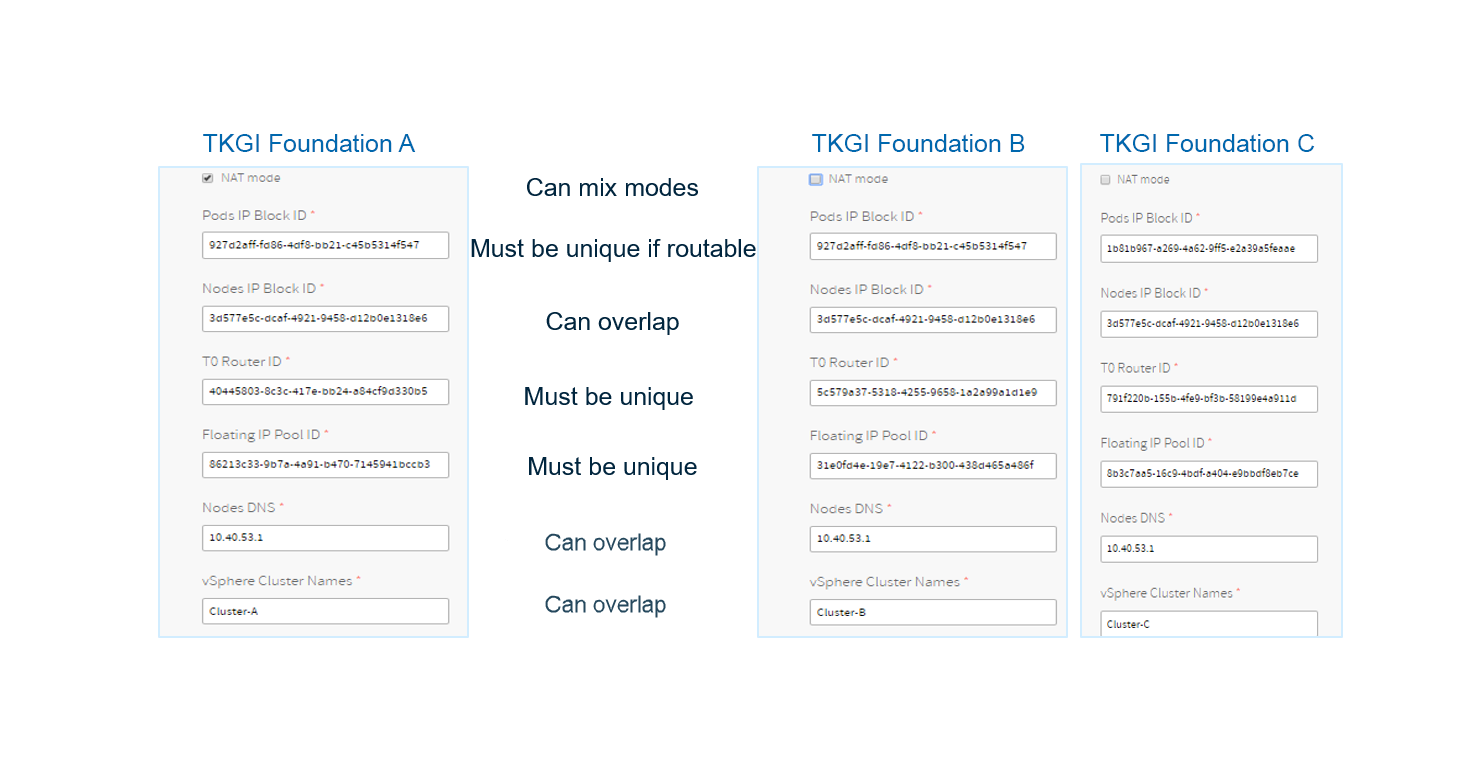This topic describes how to deploy multiple instances of VMware Tanzu Kubernetes Grid Integrated Edition (TKGI) on vSphere with NSX infrastructure.
About Multi-Foundation Tanzu Kubernetes Grid Integrated Edition
A multi-foundation deployment of Tanzu Kubernetes Grid Integrated Edition lets you install and run multiple instances of Tanzu Kubernetes Grid Integrated Edition. The purpose of a multi-foundation deployment of Tanzu Kubernetes Grid Integrated Edition is to share a common vSphere and NSX infrastructure across multiple foundations, while providing complete networking isolation across foundations.
As shown in the diagram, with a multi-foundation Tanzu Kubernetes Grid Integrated Edition topology, each TKGI instance is deployed to a dedicated NSX Tier-0 router. Foundation A T0 router with Management CIDR 10.0.0.0/16 connects to the vSphere and NSX infrastructure. Similarly, Foundation B T0 router with Management CIDR 20.0.0.0/16 connects to the same vSphere and NSX components.
As with a single instance deployment, TKGI management components are deployed to a dedicated network, for example, 10.0.0.0/24 for TKGI Foundation A; 20.0.0.0/24 for TKGI Foundation B. When Tanzu Kubernetes Grid Integrated Edition is deployed, networks are defined for nodes, pods, and load balancers. Because of the dedicated Tier-0 router, there is complete networking isolation between each Tanzu Kubernetes Grid Integrated Edition instance.

Requirements
To implement a multi-foundation Tanzu Kubernetes Grid Integrated Edition topology, adhere to the following requirements:
- One Tier-0 router for each Tanzu Kubernetes Grid Integrated Edition instance. For more information, see Isolating Tenants.
- The Floating IP pool must not overlap. The CIDR range for each Floating IP Pool must be unique and not overlapping across foundations. For more information, see Create Floating IP Pool.
- Tanzu Kubernetes Grid Integrated Edition instances can be deployed in NAT and no-NAT mode. If more than one Tanzu Kubernetes Grid Integrated Edition instance is deployed in no-NAT mode, the Nodes IP Block networks cannot overlap.
- For any Pods IP Block used to deploy Kubernetes clusters in no-NAT (routable) mode, the Pods IP Block cannot overlap across foundations.
- The NSX Super User Principal Identity Certificate is unique per TKGI instance.
The image below shows three Tanzu Kubernetes Grid Integrated Edition installations across three Tier-0 foundations. Key considerations to keep in mind with a multi-foundation Tanzu Kubernetes Grid Integrated Edition topology include the following:
- Each foundation must rely on a dedicated Tier-0 router
- You can mix-and-match NAT and no-NAT mode across foundations for Node and Pod networks
- If you are using non-routable Pods IP Block networks, the Pods IP Block addresses can overlap across foundations
- Because Kubernetes nodes are behind a dedicated Tier-0 router, if clusters are deployed in NAT mode the Nodes IP Block addresses can also overlap across foundations
- For each foundation you must define a unique Floating ID Pool with non-overlapping IPs
